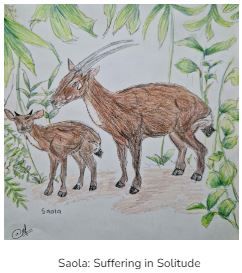Endangered Species: Saving the Last of our Wild and Wonderful

Here is an interesting fact: More than 99.9 percent of species that ever lived are now extinct. Endangered species may seem like a bland and boring topic, but what if I were to say that your actions can have a grave impact, for better or for worse, on the survival of our planet?
What is an endangered species?
Endangered species are a type of organism that is threatened by extinction. Now, why are endangered species so important to protect? The answer is quite simple: to ensure the survival of other species and to maintain a balanced ecosystem.
What is the main reason they are endangered? YOU!
Humans actively contribute to animal endangerment by continually wanting more of what they already have. Some humans destroy animal habitats by deforestation, in order to build a farm, for example. As humans, we also cause the loss of genetic variation by overhunting, overfishing and overharvesting to feed our ever-growing population.
One of the biggest issues that is caused by humans which contributes to animal endangerment is pollution. We pollute the air with the smoke produced from our factories and vehicles. We dump oil and rubbish into the oceans and litter our own lands, thus destroying ecosystems around us.
Natural causes
Animal endangerment can also be caused by natural events. For example, an erupting volcano can kill an entire species. Some organisms that became extinct due to volcanic eruptions are conodonts (eel-like fish), crocodile species and tree lizards. Extinction can happen slowly over time as nature takes over. Additional examples of natural causes include acid rain, diseases, and the competition of invasive species.
Why should YOU care?
Plants and animals maintain the health of an ecosystem. When a species becomes endangered, it is a sign that an ecosystem is out of balance. The loss of one species often triggers the loss of others. It is still never too late to save the remaining species of our planet.
For example, when grey wolves were hunted to near-extinction in the US, the beaver population also decreased significantly because the elk population, (which are usually hunted by wolves), were able to graze freely on the plant and were also needed by beavers to survive, during winter.
Since humans are sharing this planet with animals, it is inevitable that animal endangerment will affect us. For example, when the American Bison population decreased, humans who relied on them for fur and food had to find other sources.
Do you know how an endangered species gets listed?
The IUCN (International Union for Conservation of Nature) keeps a “Red List of Threatened Species”. It defines the severity and specific causes of a certain species threat of extinction. The three main categories in the Red List are Extinct, Threatened and Least Concern.
The Asian Unicorn
Critically endangered: The Asian Unicorn, also known as the enigmatic saola, is a very rarely seen animal. They are only found in the Annamite Mountains of Vietnam and Laos. The biggest threats to the saola are poaching and habitat loss. Currently there are less than 250 saola left in the wild.
The Bornean Orangutan
Critically endangered: Bornean Orangutans live in the forests of Sumatra and Borneo. They play a vital role in seed dispersal as they eat over 500 species of plants. The biggest threat to the Bornean Orangutans is habitat loss and hunting. Currently there are approximately 104,700 Bornean Orangutans left in the wild.
How do we protect them?
There are a number of steps we can take to ensure the survival of animals. We can find and rescue the animals on the brink of extinction and bring them back to health. We must allow them to breed and raise their young in safe places. We should create a stable habitat and protect them from encroachment. Ultimately, we should help endangered animals until they reach a number that gives them a fighting chance of survival.
Conclusion
Endangerment of species can lead to extinction. The extinction of a species can have disastrous impacts by affecting the food chain and ecosystem. As humans, we need to act now before it is too late. If we do not protect the animals, the survival of our planet could be at risk. Bio-diversity reduces as species decline in numbers. We can contribute a great deal to our planet by spreading awareness on endangered species and supporting conservation efforts all round.
Reference
https://people.uwec.edu/jolhm/eh4/extinction/causeslink.html
https://education.nationalgeographic.org/resource/endangered-species/
https://www.livescience.com/28076-mega-volcanoes-caused-mass-extinction.html
https://www.worldwildlife.org/species/saola
https://www.gvi.co.uk/blog/why-should-we-save-endangered-species/
https://www.worldwildlife.org/species/bornean-orangutan
Lloyd, C. (2020) All new Children’s Encyclopedia. Britannica Books
Author Biography
June was born in 2010 and is currently in her sixth year of school in the Maldives. Her interests are versatile. She enjoys writing short stories, wandering in 3D gaming worlds and exploring different artistic techniques. She hopes to publish her own novel one day.

Cite this article as:
Alisha June Ahmed Rasheed, Endangered Species: Saving the Last of our Wild and Wonderful, theCircle Composition, Volume 4, (2023).
